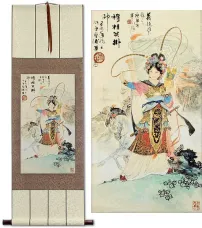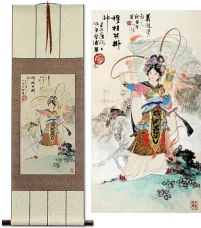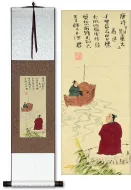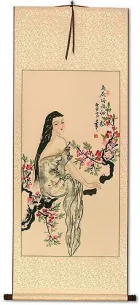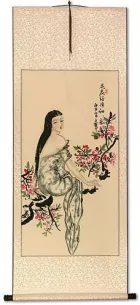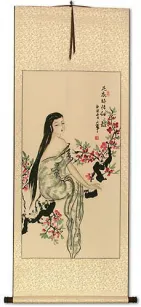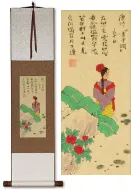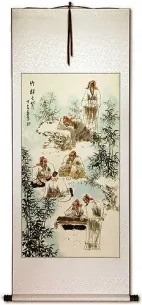Many custom options...
And formats...

Du Mu Poetry in Chinese / Japanese...
Buy a Du Mu Poetry calligraphy wall scroll here!
Mountain Travels Poem by Dumu
This poem was written almost 1200 years ago during the Tang dynasty.
It depicts traveling up a place known as Cold Mountain, where some hearty people have built their homes. The traveler is overwhelmed by the beauty of the turning leaves of the maple forest that surrounds him just as night overtakes the day, and darkness prevails. His heart implores him to stop, and take in all of the beauty around him.
First, before you get to the full translation, I must tell you that Chinese poetry is a lot different than what we have in the west. Chinese words simply don't rhyme in the same way that English or other western languages do. Chinese poetry depends on rhythm and a certain beat of repeated numbers of characters.
I have done my best to translate this poem keeping a certain feel of the original poet. But some of the original beauty of the poem in its original Chinese will be lost in translation.
Far away on Cold Mountain, a stone path leads upwards.
Among white clouds, people's homes reside.
Stopping my carriage I must, as to admire the maple forest at nights fall.
In awe of autumn leaves showing more red than even flowers of early spring.
Hopefully, this poem will remind you to stop, and “take it all in” as you travel through life.
The poet's name is “Du Mu” in Chinese that is: ![]()
![]() .
.
The title of the poem, “Mountain Travels” is: ![]()
![]()
You can have the title, poet's name, and even “Tang Dynasty” written as an inscription on your custom wall scroll if you like.
More about the poet:
Dumu lived from 803-852 AD and was a leading Chinese poet during the later part of the Tang dynasty.
He was born in Chang'an, a city in central China and the former capital of the ancient Chinese empire in 221-206 BC. In present-day China, his birthplace is currently known as Xi'an, the home of the Terracotta Soldiers.
He was awarded his Jinshi degree (an exam administered by the emperor's court which leads to becoming an official of the court) at the age of 25 and went on to hold many official positions over the years. However, he never achieved a high rank, apparently because of some disputes between various factions, and his family's criticism of the government. His last post in the court was his appointment to the office of Secretariat Drafter.
During his life, he wrote scores of narrative poems, as well as a commentary on the Art of War and many letters of advice to high officials.
His poems were often very realistic and often depicted everyday life. He wrote poems about everything, from drinking beer in a tavern to weepy poems about lost love.
The thing that strikes you most is the fact even after 1200 years, not much has changed about the beauty of nature, toils, and troubles of love and beer drinking.
This in-stock artwork might be what you are looking for, and ships right away...
Gallery Price: $108.00
Your Price: $59.88
Gallery Price: $108.00
Your Price: $59.88
Gallery Price: $160.00
Your Price: $88.77
Gallery Price: $200.00
Your Price: $88.88
Gallery Price: $200.00
Your Price: $88.88
Gallery Price: $200.00
Your Price: $88.88
Not the results for du mu poetry that you were looking for?
Below are some entries from our dictionary that may match your du mu poetry search...
| Characters If shown, 2nd row is Simp. Chinese |
Pronunciation Romanization |
Simple Dictionary Definition |
唐詩 唐诗 see styles |
táng shī tang2 shi1 t`ang shih tang shih toushi / toshi とうし |
Tang poetry; a Tang poem poetry of the Tang period; Tang poetry |
詩壇 诗坛 see styles |
shī tán shi1 tan2 shih t`an shih tan shidan しだん |
poetry circles; poetry world poetic circles; world of poetry |
句 see styles |
jù ju4 chü ku く |
sentence; clause; phrase; classifier for phrases or lines of verse (n,n-suf) (1) section (i.e. of text); sentence; passage; paragraph; (n,n-suf) (2) {ling} phrase; (n,n-suf) (3) verse (of 5 or 7 mora in Japanese poetry; of 4, 5, or 7 characters in Chinese poetry); (n,n-suf) (4) haiku; first 17 morae of a renga, etc.; (n,n-suf) (5) maxim; saying; idiom; expression; (n,n-suf) (6) {comp} clause (e.g. in a database query language) A sentence, phrase, clause; also used for a place. |
吟 see styles |
yín yin2 yin gin ぎん |
to chant; to recite; verse; song (often used in titles of classical poems); (literary) to lament; to groan; (bound form) (in poetry) the cry of certain animals and insects; (music) rapid vibrato (technique for playing the guqin 古琴[gu3qin2]) (cf. 猱[nao2], wide vibrato) (1) recitation (of a poem); chanting; singing; (2) composition (of a poem); composed poem; (n,n-suf) (3) classical Chinese poetry form; (n,suf) (4) stress of sound in noh song; (female given name) Gin Chant, hum, mutter. |
歌 see styles |
gē ge1 ko kasumi かすみ |
song; CL:支[zhi1],首[shou3]; to sing (1) song; (2) classical Japanese poetry (esp. tanka); (3) modern poetry; (personal name) Kasumi To sing; a song; translit. ka; cf. 迦, 羯. |
詞 词 see styles |
cí ci2 tz`u tzu shi し |
word; statement; speech; lyrics; a form of lyric poetry, flourishing in the Song dynasty 宋朝[Song4chao2] (CL:首[shou3]) (1) words; writing; lyrics; (2) (See 填詞) ci (form of Chinese poetry); (3) (See 辞・3) independent word; (female given name) Kotoba An expression, phrase, word. |
詩 诗 see styles |
shī shi1 shih shi し |
poem; CL:首[shou3]; poetry; verse (1) poem; poetry; verse; (2) (See 漢詩) Chinese poem; (female given name) Shirabe poem |
召人 see styles |
meshiudo; meshuudo / meshiudo; meshudo めしうど; めしゅうど |
(1) (See 歌会始) person specially invited to compose and recite a poem at the Imperial New Year's Poetry Reading; (2) (hist) person employed by the Imperial Court to compile anthologies of waka poetry; (3) (hist) (See 舞楽) person summoned to perform bugaku (for the nobility) |
平仄 see styles |
píng zè ping2 ze4 p`ing tse ping tse hyousoku / hyosoku ひょうそく |
level and oblique tones (technical term for Classical Chinese rhythmic poetry) meter (in Chinese poetry); consistency |
探題 see styles |
tandai たんだい |
(1) local commissioner (Kamakura or Muromachi eras); (2) draw to find the theme for poetry session; composing poetry by lot |
檀林 see styles |
tán lín tan2 lin2 t`an lin tan lin danbayashi だんばやし |
(1) (Buddhist term) Buddhist center for study and meditation; monastery; temple; (2) (abbreviation) Danrin style of haikai poetry (playful and oriented to the common person); Danrin school (of haikai poetry); (surname) Danbayashi 旃檀之林 Forest of sandal-wood, or incense, a monastery. |
歌枕 see styles |
utamakura うたまくら |
(1) place that is often written about in waka poetry; (2) oft-repeated descriptive epithets in poetry; (personal name) Kazuraki |
歌格 see styles |
kakaku かかく |
poetry style; poetry rules |
詩史 see styles |
shishi しし |
(1) history of poetry (esp. Chinese); (2) history recorded in the form of poetry; (female given name) Shifumi |
詩文 诗文 see styles |
shī wén shi1 wen2 shih wen shibun しぶん |
poetry and literature poetry and prose; literature; literary works; (female given name) Shifumi |
詩書 诗书 see styles |
shī shū shi1 shu1 shih shu shisho ししょ |
the Book of Songs 詩經|诗经[Shi1 jing1] and the Book of History 書經|书经[Shu1 jing1] (1) book of poetry; (2) The Classic of Poetry and The Classic of History (Chinese texts) |
詩歌 诗歌 see styles |
shī gē shi1 ge1 shih ko shiika / shika しいか |
poem; CL:本[ben3],首[shou3],段[duan4] (1) Japanese and Chinese poetry; (2) poetry; poems; (female given name) Shiika |
詩畫 诗画 see styles |
shī huà shi1 hua4 shih hua |
poetry and pictorial art; work of art combining pictures and poetry |
詩話 诗话 see styles |
shī huà shi1 hua4 shih hua |
notes on poetry, an essay genre consisting of informal commentary on poems and poets and their lives (old); a genre of narrative literature interspersing prose with poetry, popular in the Tang and Song dynasties |
詩論 see styles |
shiron しろん |
essay on poetry; theory of poetry |
詩集 诗集 see styles |
shī jí shi1 ji2 shih chi shishuu / shishu ししゅう |
poetry anthology poetry anthology; collection of poems; collected poems; (female given name) Shizu |
談林 谈林 see styles |
tán lín tan2 lin2 t`an lin tan lin danrin だんりん |
(1) (Buddhist term) Buddhist center for study and meditation; monastery; temple; (2) (abbreviation) Danrin style of haikai poetry (playful and oriented to the common person); Danrin school (of haikai poetry) A monastic school room. |
山家集 see styles |
sankashuu / sankashu さんかしゅう |
(work) Sankashu (personal collection of Japanese poetry by Saigyo); (wk) Sankashu (personal collection of Japanese poetry by Saigyo) |
山水詩 山水诗 see styles |
shān shuǐ shī shan1 shui3 shi1 shan shui shih |
shanshui poetry, genre of Classical Chinese poetry |
抒情詩 抒情诗 see styles |
shū qíng shī shu1 qing2 shi1 shu ch`ing shih shu ching shih jojoushi / jojoshi じょじょうし |
lyric poetry lyric poetry; lyric poem; ode |
朦朧詩 朦胧诗 see styles |
méng lóng shī meng2 long2 shi1 meng lung shih |
Misty Poetry, a post-Cultural Revolution poetry movement |
近代詩 see styles |
kindaishi きんだいし |
modern poetry; modern-style poetry |
吟風弄月 吟风弄月 see styles |
yín fēng nòng yuè yin2 feng1 nong4 yue4 yin feng nung yüeh gonfu rugetsu |
lit. singing of the wind and the moon; fig. vacuous and sentimental (of poetry or art) to recite poetry along with the blowing of the wind while enjoying a beautiful view of the moon |
詩歌管弦 see styles |
shiikakangen / shikakangen しいかかんげん |
(yoji) Chinese and Japanese poetry and instrumental music; poetry and music; literature and music |
Variations: |
danrin だんりん |
(1) {Buddh} (abbreviation of 栴檀林) (See 栴檀・1) Buddhist center for study and meditation; monastery; temple; (2) (abbreviation) (See 俳諧・1,談林風,談林派) Danrin style of haikai poetry (playful and oriented to the common person); Danrin school (of haikai poetry) |
Click here for more du mu poetry results from our dictionary
The following table may be helpful for those studying Chinese or Japanese...
| Title | Characters | Romaji (Romanized Japanese) | Various forms of Romanized Chinese | |
| Mountain Travels Poem by Dumu | 遠上寒山石徑斜白雲生處有人家停車坐愛楓林晚霜葉紅於二月花 远上寒山石径斜白云生处有人家停车坐爱枫林晚霜叶红于二月花 | yuǎn shàng hán shān shí jìng xiá bái yún shēng chù yǒu rén jiā tíng chē zuò ài fēng lín wǎn shuàng yè hóng yú èr yuè huā yuan3 shang4 han2 shan1 shi2 jing4 xia2 bai2 yun2 sheng1 chu4 you3 ren2 jia1 ting2 che1 zuo4 ai4 feng1 lin2 wan3 shuang4 ye4 hong2 yu2 er4 yue4 hua1 yuan shang han shan shi jing xia bai yun sheng chu you ren jia ting che zuo ai feng lin wan shuang ye hong yu er yue hua | yüan shang han shan shih ching hsia pai yün sheng ch`u yu jen chia t`ing ch`e tso ai feng lin wan shuang yeh hung yü erh yüeh hua yüan shang han shan shih ching hsia pai yün sheng chu yu jen chia ting che tso ai feng lin wan shuang yeh hung yü erh yüeh hua |
|
| In some entries above you will see that characters have different versions above and below a line. In these cases, the characters above the line are Traditional Chinese, while the ones below are Simplified Chinese. | ||||
Successful Chinese Character and Japanese Kanji calligraphy searches within the last few hours...

